Trigger Point Therapy for Myofascial Pain (21 page)
Read Trigger Point Therapy for Myofascial Pain Online
Authors: L.M.T. L.Ac. Donna Finando

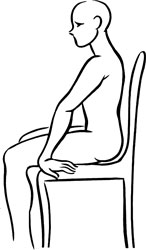
Stretch exercise: Brachialis
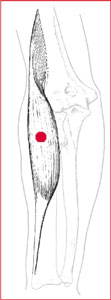
Brachioradialis and trigger point
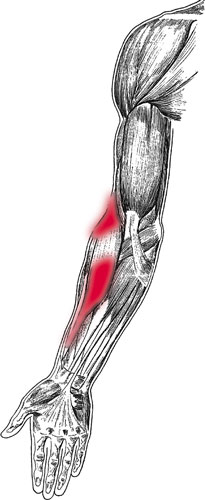
Brachioradialis (anterior) pain pattern
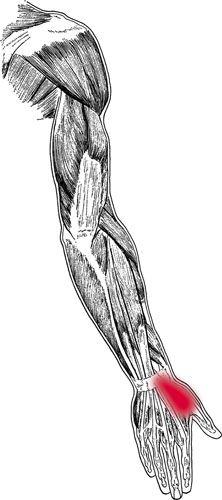
Brachioradialis (posterior) pain pattern
B
RACHIORADIALIS
Proximal attachment:
Lateral supracondylar ridge of the humerus and the lateral intermuscular septum at the level of the mid-arm.
Distal attachment:
Styloid process of the radius.
Action:
Flexion of the forearm at the elbow, expecially when the arm is in the neutral position; assists resisted pronation and supination of the forearm.
Palpation:
Brachioradialis is the most superficial muscle of the lateral aspect of the forearm. It gives the upper forearm its characteristic shape.
To locate brachioradialis, identify the following structures:
- Lateral supracondylar ridge of the humerusâThe vertical ridge on the lateral aspect of the humerus starting just above the lateral epicondyle
- Styloid process of the radiusâThe lateral, distal end of the radius
To locate brachioradialis, flex the elbow against resistance with the forearm in the neutral (midprone) positionâhold a light fist and press up against the bottom of a tabletop using the index finger/thumb part of the fist. The brachioradialis becomes clearly prominent. With the forearm in the neutral position, palpate brachioradialis from its attachment on the humerus, through the muscle belly, to its tendinous attachment on the styloid process of the radius.
Pain pattern:
Pain experienced at the lateral epicondyle through the length of the muscle to the web of the thumb on the dorsal aspect of the hand. The pain is often described as “tennis elbow” and is accompanied by a weak or unreliable grip.
Causative or perpetuating factors:
Forceful or repetitive gripping of a large or wide object.
Satellite trigger points:
Hand extensors.
Affected organ system:
Respiratory system.
Associated zones, meridians, and points:
Ventral zone; Hand Tai Yin Lung meridian; LU 4, 5, and 6.
Stretch exercise:
With the elbow straight and the arm supinated, fully extend the wrist and place the hand in ulnar deviation.
Strengthening exercise:
Stand with the arms at your sides, palms facing outward. Flex the forearms and, keeping the elbows close to the body, draw the palms toward the shoulder. Slowly return to the starting position. Flex to a count of two; release to a count of four.
Repeat eight to ten times, increasing repetitions as strength allows. Hand weights may be used to increase the work effort placed on the muscle.

Stretch exercise: Brachioradialis

Hand and finger extensors and trigger points
H
AND
AND
F
INGER
E
XTENSORS
E
XTENSOR CARPI RADIALIS LONGUS
, E
XTENSOR CARPI RADIALIS BREVIS
, E
XTENSOR DIGITORUM
, E
XTENSOR DIGITI MINIMI
, E
XTENSOR CARPI ULNARIS
1
Proximal attachment:
Extensor carpi radialis longus:
lateral epicondyle of the humerus via the common extensor tendon and the lateral supracondylar ridge.
Extensor carpi radialis brevis:
lateral epicondyle of the humerus via the common extensor tendon.
Extensor digitorum:
lateral epicondyle of the humerus, intermuscular septum, and antebrachial fascia.
Extensor digiti minimi:
lateral epicondyle of the humerus via the common extensor tendon.
Extensor carpi ulnaris:
lateral epicondyle of the humerus via the common extensor tendon, and the proximal ulna.
Distal attachment:
Extensor carpi radialis longus:
base of the second metacarpal
. Extensor carpi radialis brevis:
base of the third metacarpal.
Extensor digitorum:
middle and distal phalanges of each of the four fingers.
Extensor digiti minimi:
middle and distal phalanges of the little finger.
Extensor carpi ulnaris:
base of the fifth metacarpal.
Action:
Extensor carpi radialis longus:
extension and radial deviation of the hand
. Extensor carpi radialis brevis:
extension of the hand.
Extensor digitorum:
extension of the four fingers.
Extensor digiti minimi:
extension and abduction of the little finger.
Extensor carpi ulnaris:
extension and ulnar deviation of the hand.
Palpation:
Each of these superficial muscles of the dorsal forearm can harbor constrictions that may be the source of myofascial pain. It is recommended that areas of constriction be located using digital palpation along the dorsal (posterior) forearm, following the course of each muscle as it moves from its proximal position at the lateral epicondyle to the wrist and hand. In order to identify each muscle, move the hand and fingers through the actions performed by each individual muscle as you palpate.
Pain pattern:
Pain over the lateral epicondyle and the dorsum of the forearm and hand and possibly throughout the fingers. Pain may be described as “tennis elbow” and may be accompanied by a weak or unreliable grip. Weakness is pronounced when the hand is in ulnar deviation.
Causative or perpetuating factors:
Repetitive or forceful handgrip; “writer's cramp.”
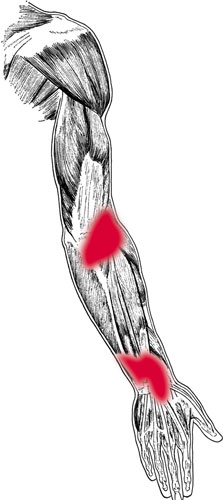
Hand and finger extensors pain pattern
Satellite trigger points:
Brachioradialis.
Affected organ system:
Digestive system.
Associated zones, meridians, and points:
Dorsal zone; Hand Tai Yang Small Intestine meridian, Hand Yang Ming Colon meridian, Hand Shao Yang Triple Warmer meridian; SI 6, 7, and 8; CO 5â11; SJ 4â10.
Stretch exercise:
Flex the wrist with the elbow fully extended. While maintaining the extended elbow, place the dorsum of the hand on a table to increase the stretch, or stabilize the flexed hand using the opposite hand.
Strengthening exercise:
Form a light fist while maintaining a neutral or slightly flexed wrist position. Keeping the elbow fully extended, extend the wrist. Return to a neutral position. Repeat eight to ten times. Light hand weights may be used to increase the work effort of the hand extensors.
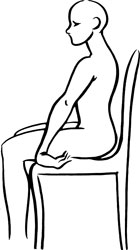
Stretch exercise: Hand extensors